
Chinese Journal of Applied Chemistry ›› 2023, Vol. 40 ›› Issue (4): 518-526.DOI: 10.19894/j.issn.1000-0518.220397
• Full Papers • Previous Articles Next Articles
A Novel Electrochemical Method for Berberine Detection in Biological Fluids
- School of Pharmacy,Anhui University of Chinese Medicine,Hefei 230012,China
-
Received:2022-12-09Accepted:2023-03-07Published:2023-04-01Online:2023-04-17 -
Contact:Zi-Pin ZHANG -
About author:zpzhang@ahtcm.edu.cn
-
Supported by:the Natural Science Foundation of Anhui Province of China(2008085MH293);Anhui Province Foundation for the Returned Scholars (No.19) and Key Project of Research Foundation of Education Commission of Anhui Province(2022AH050459)
CLC Number:
Cite this article
Rui ZHOU, Zi-Pin ZHANG. A Novel Electrochemical Method for Berberine Detection in Biological Fluids[J]. Chinese Journal of Applied Chemistry, 2023, 40(4): 518-526.
share this article
Add to citation manager EndNote|Ris|BibTeX
URL: http://yyhx.ciac.jl.cn/EN/10.19894/j.issn.1000-0518.220397
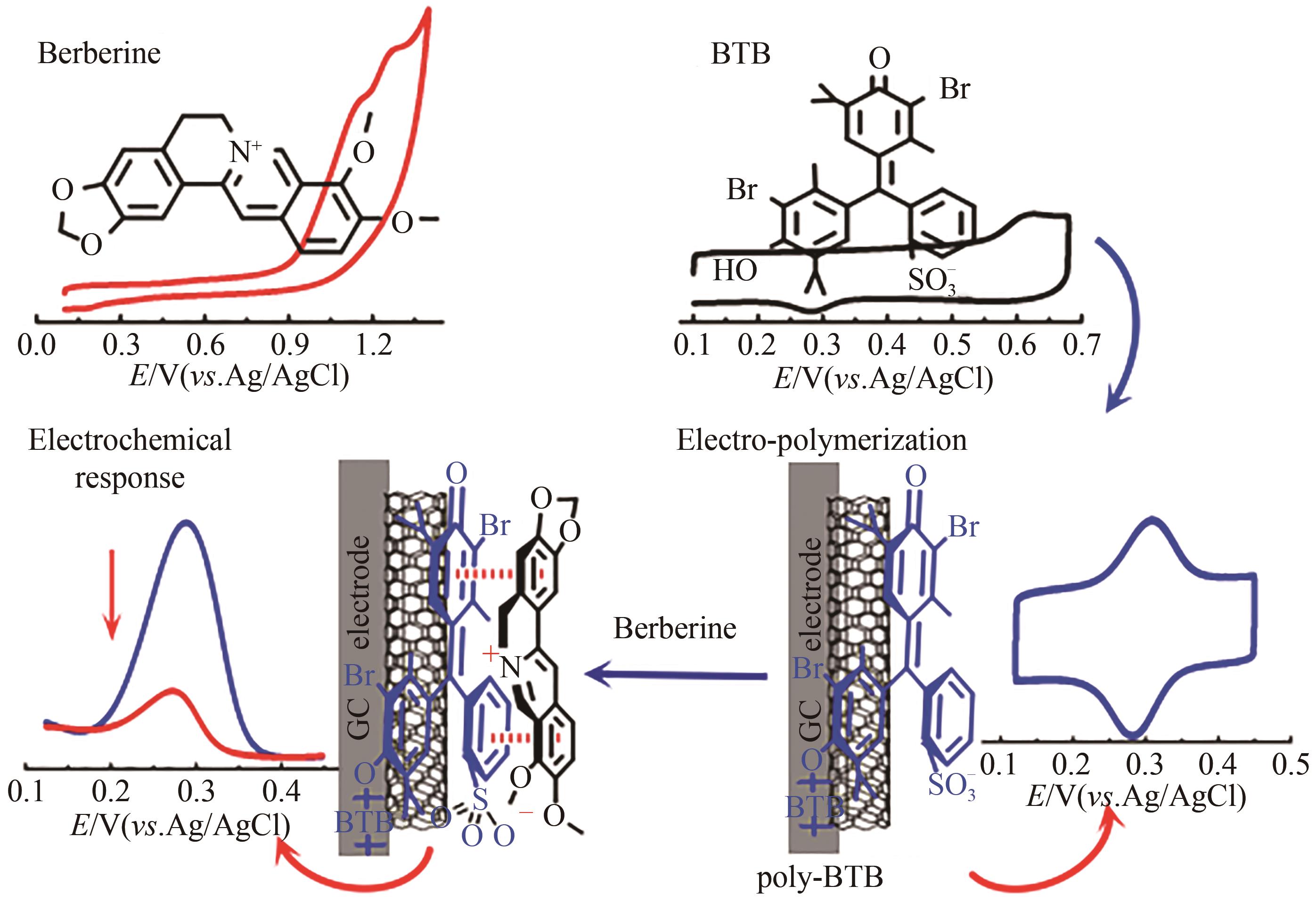
Fig.1 Chemical structures of berberine and BTB, and schematic illustration of the strategy for electrochemical detection of berberine based on poly-BTB modified electrode
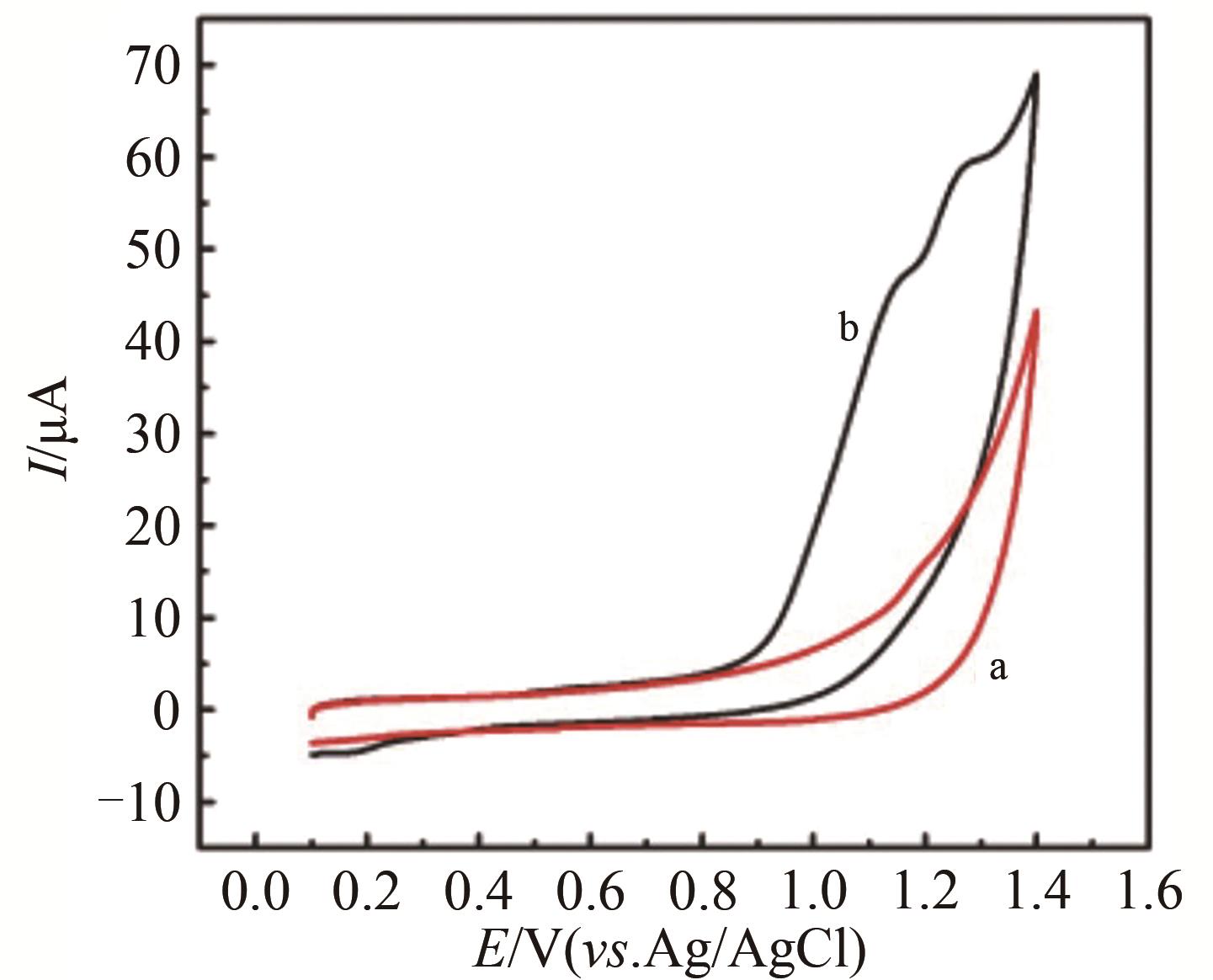
Fig.2 Typical cyclic voltammograms (CVs) obtained at the SWNTs/GC electrode in BR buffer solution of pH=5.0 in the absence (a) and presence of 500 μmol/L berberine (b). Scan rate is 50 mV/s
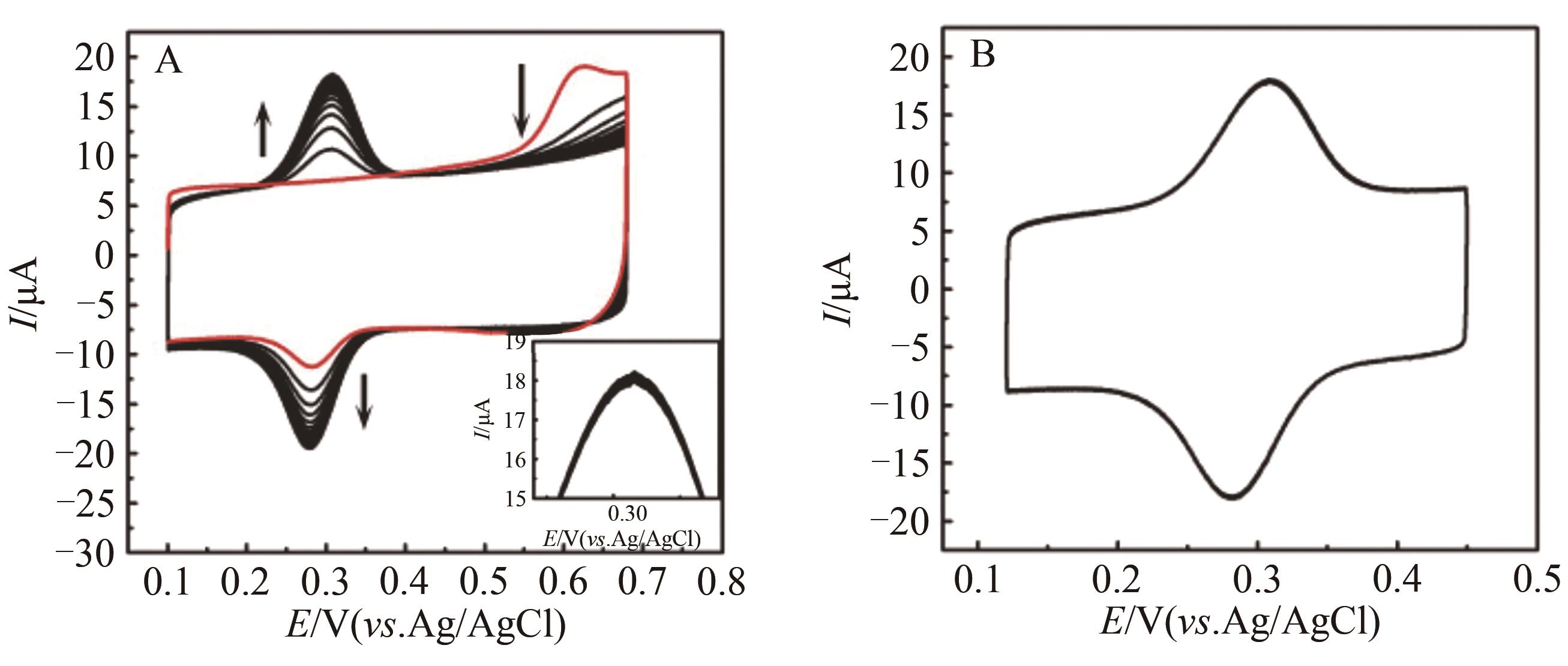
Fig.3 Successive 20-cycle CV at the BTB/SWNTs/GC electrode (A) and successive 50-cycle CV at poly-BTB/SWNTs/GC electrode (B) in BR buffer solution of pH=5.0. Scan rate is 50 mV/s. The red curve in Fig.3A represents the first cycle of the CV, and the arrows indicate the directions of the cycle numbers from 1 to 20 in Fig.3A. The insert shows the magnification of the 15th to 20 th cycles of the CVs in Fig.3A

Fig.4 (A) Typical CVs obtained at the poly-BTB/SWNTs/GC electrode (a, b) and SWNTs/GC electrode (c) in BR buffer solution of pH=5.0 before (a) and after (b, c) 20 min incubation with 500 μmol/L berberine. Scan rate is 50 mV/s;
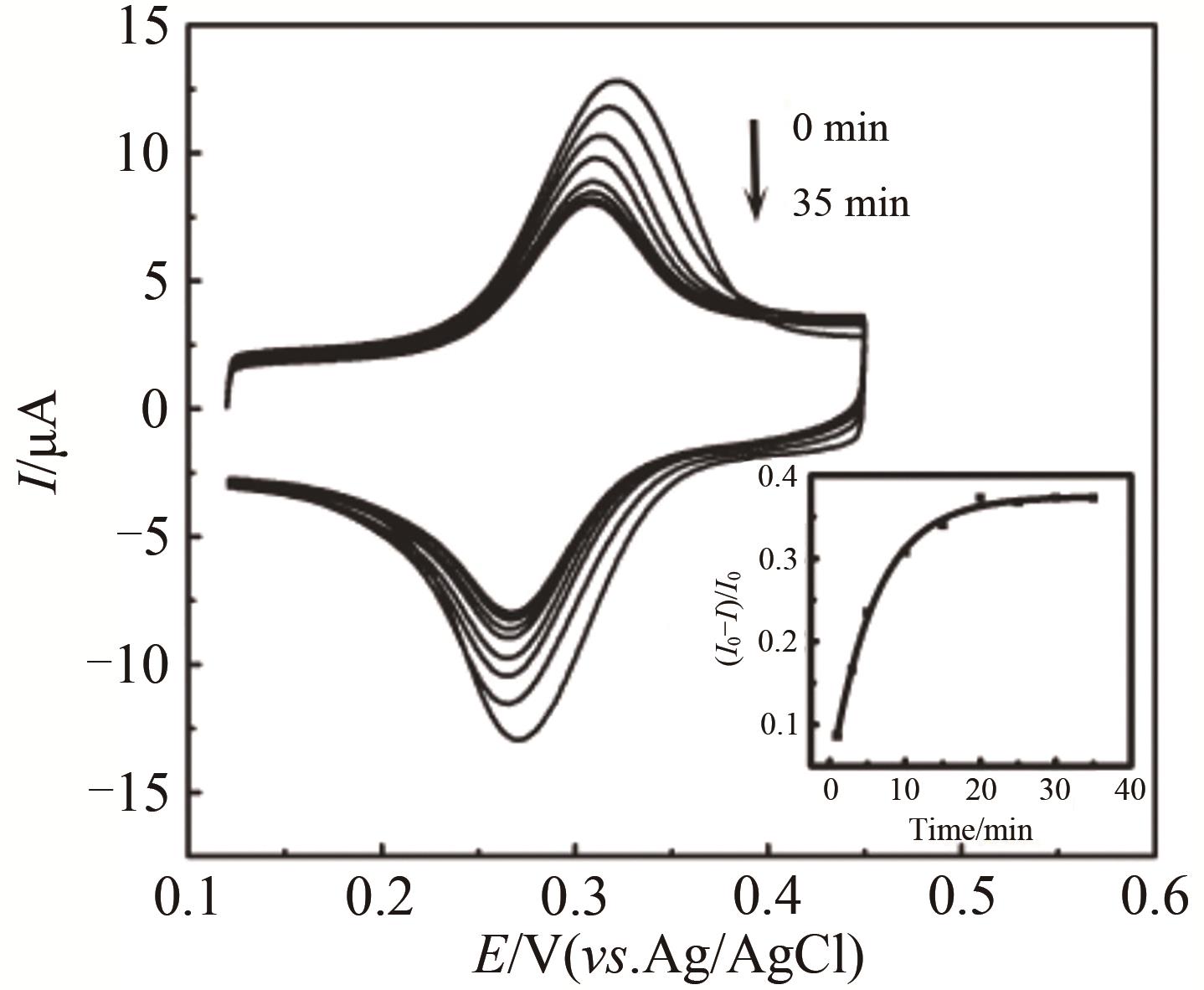
Fig.5 Typical CVs obtained at the poly-BTB/SWNTs/GC electrode in BR buffer solution of pH=5.0 after incubation with 500 μmol/L berberine for 0, 1, 3, 5, 10, 15, 20, 25, 30 and 35 mins. Scan rate, 50 mV/s. The arrow indicates the direction of increasing of the incubation span. Inset the nonlinear plot of the ratio of current decrease versus incubation time
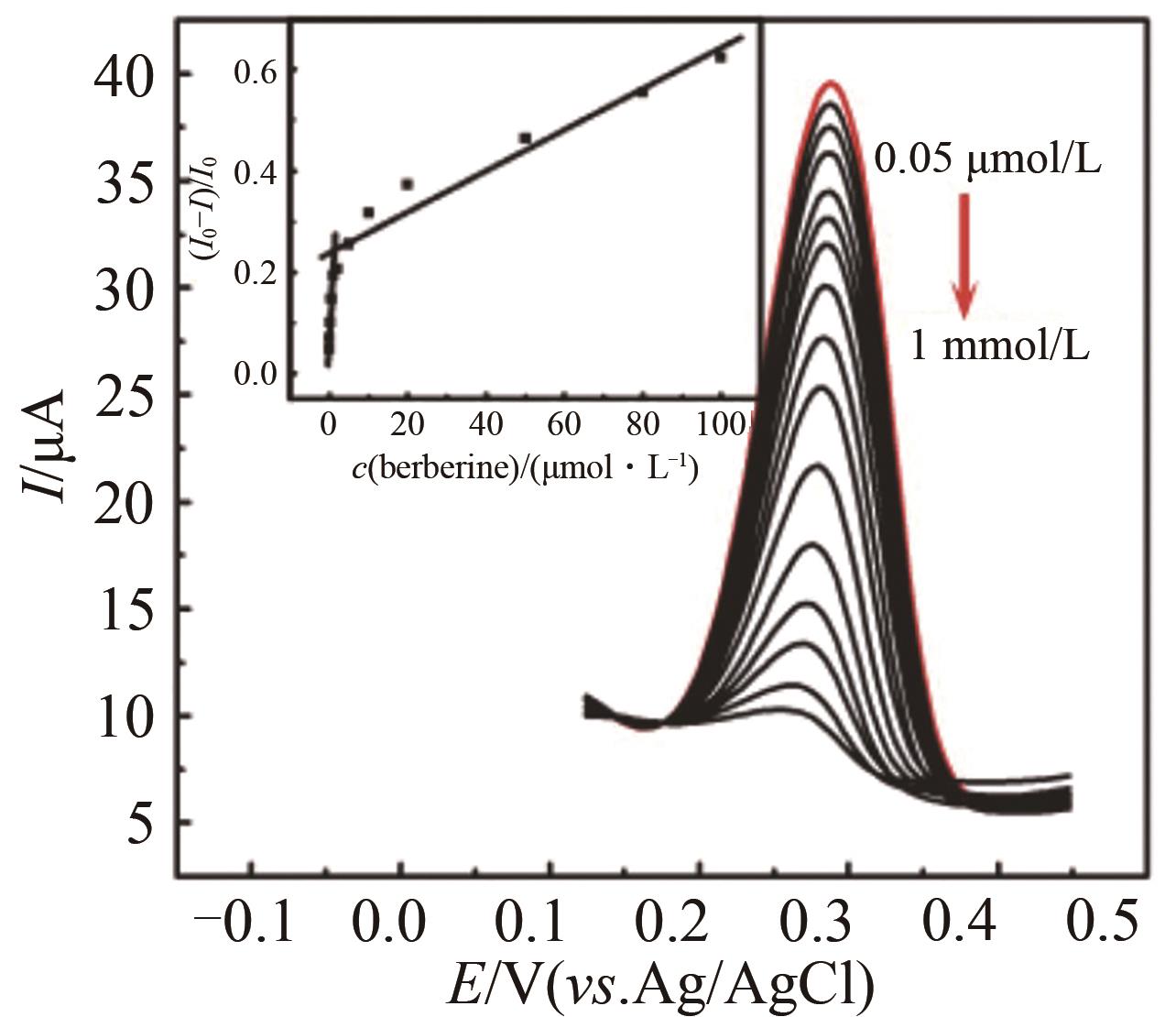
Fig.6 Typical DPVs obtained at poly-BTB/SWNTs-modified GC electrode in BR buffer solution of pH=5.0 upon addition of different concentrations of berberine. The arrow indicates the direction of increasing concentration of berberine. Inset: linear plot of the ratio of current decrease versus concentration of berberine in the ranges of 0.05~1 μmol/L and 1~100 μmol/L
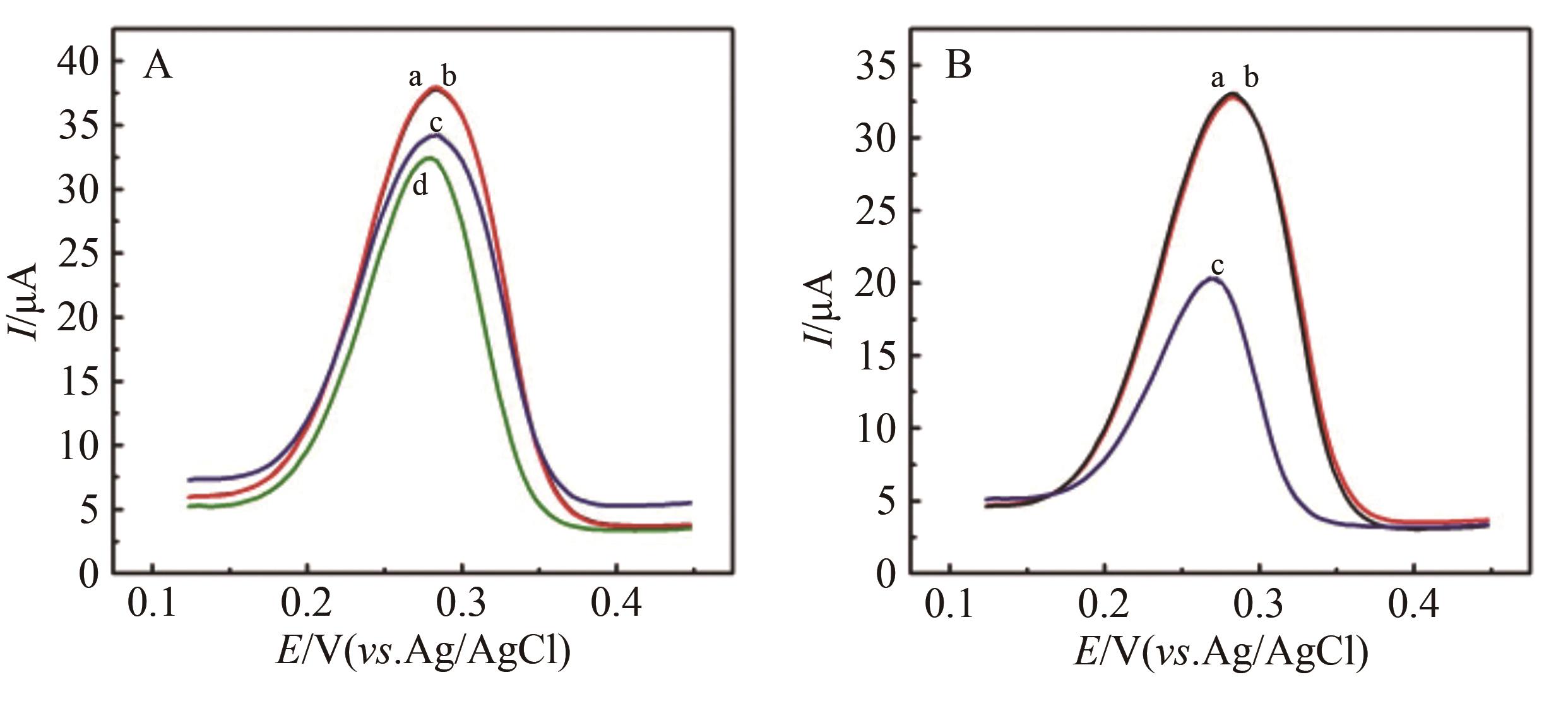
Fig.7 (A) Typical DPVs obtained at the poly-BTB/SWNTs-modified GC electrodes in BR buffer solution of pH=5.0 in the absence (a) and the presence of 10 μL blank plasma (b), and 10 μL model plasma of rats after dosing of berberine for 1 h (c) and 2 h (d). (B) Typical DPVs obtained at the poly-BTB/SWNTs-modified GC electrodes in BR buffer solution of pH=5.0 in the absence (a) and the presence of 10 μL blank liver homogenate (b) and 10 μL model plasma of rats after dosing of berberine for 3 h (c)
| Sample | Spiked/(μmol·L-1) | Found/(μmol·L-1) | Recovery/% | RSD/% |
|---|---|---|---|---|
| Plasma | 0.20 | 0.20 | 100.0 | 2.5 |
| 20 | 20.64 | 103.2 | 1.9 | |
| Liver homogenate | 50 0.20 20 50 | 51.08 0.20 19.37 50.49 | 102.2 101.5 96.9 100.9 | 2.0 4.6 3.2 1.6 |
Table 1 Spike-and-recovery in plasma and liver homogenate(n=3)
| Sample | Spiked/(μmol·L-1) | Found/(μmol·L-1) | Recovery/% | RSD/% |
|---|---|---|---|---|
| Plasma | 0.20 | 0.20 | 100.0 | 2.5 |
| 20 | 20.64 | 103.2 | 1.9 | |
| Liver homogenate | 50 0.20 20 50 | 51.08 0.20 19.37 50.49 | 102.2 101.5 96.9 100.9 | 2.0 4.6 3.2 1.6 |
| 1 | ALBRING K F, WEIDEMULLER J, MITTAG S, et al. Berberine acts as a natural inhibitor of Wnt/β-catenin signaling-identification of more active 13-arylalkyl derivatives[J]. Biofactors, 2013, 39(6): 652-662. |
| 2 | IMENSHAHIDI M, HOSSEINZADEH H. Berberis vulgaris and berberine: an update review[J]. Phytother Res, 2016, 30(11): 1745-1764. |
| 3 | 于浩, 杜建玲. 小檗碱的药理作用及机制的研究现状[J]. 中国现代应用药学, 2020, 37(4): 501-507. |
| YU H, DU J L. Research progress on pharmacological effect and mechanism action of berberine[J]. Chin J Mod Appl Pharm, 2020, 37(4): 501-507. | |
| 4 | 邢宇, 刘鑫, 林园, 等. 小檗碱药理作用及其临床应用研究进展[J]. 中国药理学与毒理学杂志, 2017, 31(6): 491-502. |
| XING Y, LIU X, LIN Y, et al. Progress in pharmacological effects and clinical applications of berberine[J]. Chin J Pharmacol Toxicol, 2017, 31(6): 491-502. | |
| 5 | CICERO A F, FERRONI A, ERTEK S. Tolerability and safety of commonly used dietary supplements and nutraceuticals with lipid-lowering effects[J]. Expert Opin Drug Saf, 2012, 11(5): 753-766. |
| 6 | HUANG P, QIAN X, LI J, et al. Simultaneous determination of 11 alkaloids in crude and wine-processed rhizoma coptidis by HPLC-PAD[J]. J Chromatogr Sci, 2015, 53(1): 73-78. |
| 7 | 闫丽莉, 宋小雪, 陈忠新, 等. 高效液相色谱法测定半夏泻心汤物质基准中盐酸小檗碱的含量[J]. 化学工程师, 2022, 36(1): 22-25. |
| YAN L L, SONG X X, CHEN Z X, et al. Determination of berberine hydrochloride in Banxia Xiexin Decoction by HPLC[J]. Chem Eng, 2022, 36(1): 22-25. | |
| 8 | 涂星, 唐洪梅, 柴玉娜, 等. 反相高效液相色谱法测定肠激安胶囊中芍药苷、盐酸小檗碱和盐酸巴马汀含量[J]. 药物分析杂志, 2015, 35(1): 115-120. |
| TU X, TANG H M, CAI Y N, et al. Determination of paeoniflorin,berberine hydrochloride and palmatine hydrochloride in Changji'an capsules by RP-HPLC[J]. Chin J Pharm Anal, 2015, 35(1): 115-120. | |
| 9 | WANG Y, ZHANG Y, XIAO J, et al. Simultaneous determination of baicalin, baicalein, wogonoside, wogonin, scutellarin, berberine, coptisine, ginsenoside Rb1 and ginsenoside Re of Banxia xiexin decoction in rat plasma by LC-MS/MS and its application to a pharmacokinetic study[J]. Biomed Chromatogr, 2018, 32(2): 4083-4093. |
| 10 | CHEN J, ZHAO H, WANG X, et al. Analysis of major alkaloids in rhizoma coptidis by capillary electrophoresis-electrospray-time of flight mass spectrometry with different background electrolytes[J]. Electrophoresis,2008, 29(10): 2135-2147. |
| 11 | BIPARVA P, ABEDIRAD S M, KAZEMI S Y, et al. Chemiluminescence recognition of berberine triggered by biomimetically synthesized silver nanoparticles[J]. Sens Actuators B: Chem, 2016, 234: 278-285. |
| 12 | WU Y, ZHANG Q, ZHAO Y, et al. A sensitive and selective fluorescent sensor for berberine chloride based on the supramolecular self-assembly of perylene diimide in aqueous solution[J]. ACS Sustain Chem Eng,2020, 8 (16): 6517-6523. |
| 13 | WANG J S, SAKTHIVEL R, ANBAZHAGAN R, et al. Electroactive polypyrrole-molybdenum disulfide nanocomposite for ultrasensitive detection of berberine in rat plasma[J]. Anal Chim Acta, 2020, 1125: 210-219. |
| 14 | GETO A, PITA M, DE LACEY A L, et al. Electrochemical determination of berberine at a multi-walled carbon nanotubes-modified glassy carbon electrode[J]. Sens Actuators B: Chem,2013, 183: 96-101. |
| 15 | SHIMADA T, HASEGAWA T. Determination of equilibrium structures of bromothymol blue revealed by using quantum chemistry with an aid of multivariate analysis of electronic absorption spectra[J]. Spectrochim Acta A Mol Biomol Spectrosc, 2017, 185: 104-110. |
| 16 | RUBIO A L R, BLANCO C, SANCHEZ F G. Synchronous scanning first and second derivative spectrofluorimetric determination of the alkaloid berberine[J]. Fresenius Z Anal Chem, 1986, 323(2): 153-156. |
| 17 | 胡宇莉, 陈超, 邹宗尧, 等. 8-十六烷基小檗碱与小檗碱的大鼠药代动力学和组织分布比较研究[J]. 药学学报, 2014, 49(11): 1582-1587. |
| HU Y L, CHEN C, ZOU Z Y, et al. Comparative study of pharmacokinetics and tissue distribution of 8-cetylberberine and berberine in rats[J]. Acta Pharm Sin, 2014, 49(11): 1582-1587. | |
| 18 | SKOPALOVA J, VACEK J, PAPOUSKOVA B, et al. Electrochemical oxidation of berberine and mass spectrometric identification of its oxidation products[J]. Bioelectrochemistry, 2012, 87: 15-20. |
| 19 | PRADHAN P, MASCARENHAS R J, THOMAS T, et al. Electropolymerization of bromothymol blue on carbon paste electrode bulk modified with oxidized multiwall carbon nanotubes and its application in amperometric sensing of epinephrine in pharmaceutical and biological samples[J]. J Electroanal Chem, 2014, 732: 30-37. |
| 20 | 冯宇婷, 申贵隽, 黄慧娟. 溴百里酚蓝/多壁碳纳米管修饰玻碳电极测定冬虫夏草中腺嘌呤[J]. 理化检验(化学分册), 2017, 53(1): 60-63. |
| FENG Y T, SHEN G J, HUANG H J. MWCNTs/BTB modified glassy carbon electrode determination of adenine in Cordyceps sinensis[J]. Phys Testing Chem Anal Part B: Chem Anal, 2017, 53(1): 60-63. |
| [1] | ZHOU Kai,WENG Ying,HOU Qingqing,LOU Benyong. Preparation, Crystal Structure and Solubility of Organic Salt Hydrate of Berberine-Genistein [J]. Chinese Journal of Applied Chemistry, 2019, 36(2): 230-235. |
| [2] | Jianping YANG, Tingting SU, Xiaozhen QIU, Hanjie ZHANG, Yali WANG, wei YIN. Screening of Hypoglycemic Constituents in Chinese Herbal Medicine Based on Electrochemical Amperometric Detection [J]. Chinese Journal of Applied Chemistry, 2018, 35(7): 842-848. |
| [3] | TANG Huanfeng, HUANG Zaiyin, LIU Zuojiao. In-situ Growth Mechanism and Thermodynamic Functions of ZnO Nanosheet Structures [J]. Chinese Journal of Applied Chemistry, 2016, 33(10): 1196-1202. |
| [4] | ZHANG Shenyang, LIAO Qiangqiang*, XU Shaodi, YANG Dong, ZHAO Lulu, GE Honghua. Inhibitive Effect of the Self-assembled Monolayers of Dithiocarbamate Modified Glucose on Copper Surface [J]. Chinese Journal of Applied Chemistry, 2013, 30(05): 596-601. |
| [5] | Dilbar Ahmat1, Erkin Tursun2, Xawkat Abliz2, Abliz Yimit2*. Fabrication of Composite Optical Waveguides Based on Thin Films Consisted of Iron Phosphate Nanoparticles and Their Applications as Ammonia Gas Sensor [J]. Chinese Journal of Applied Chemistry, 2010, 27(08): 965-969. |
| Viewed | ||||||
|
Full text |
|
|||||
|
Abstract |
|
|||||
